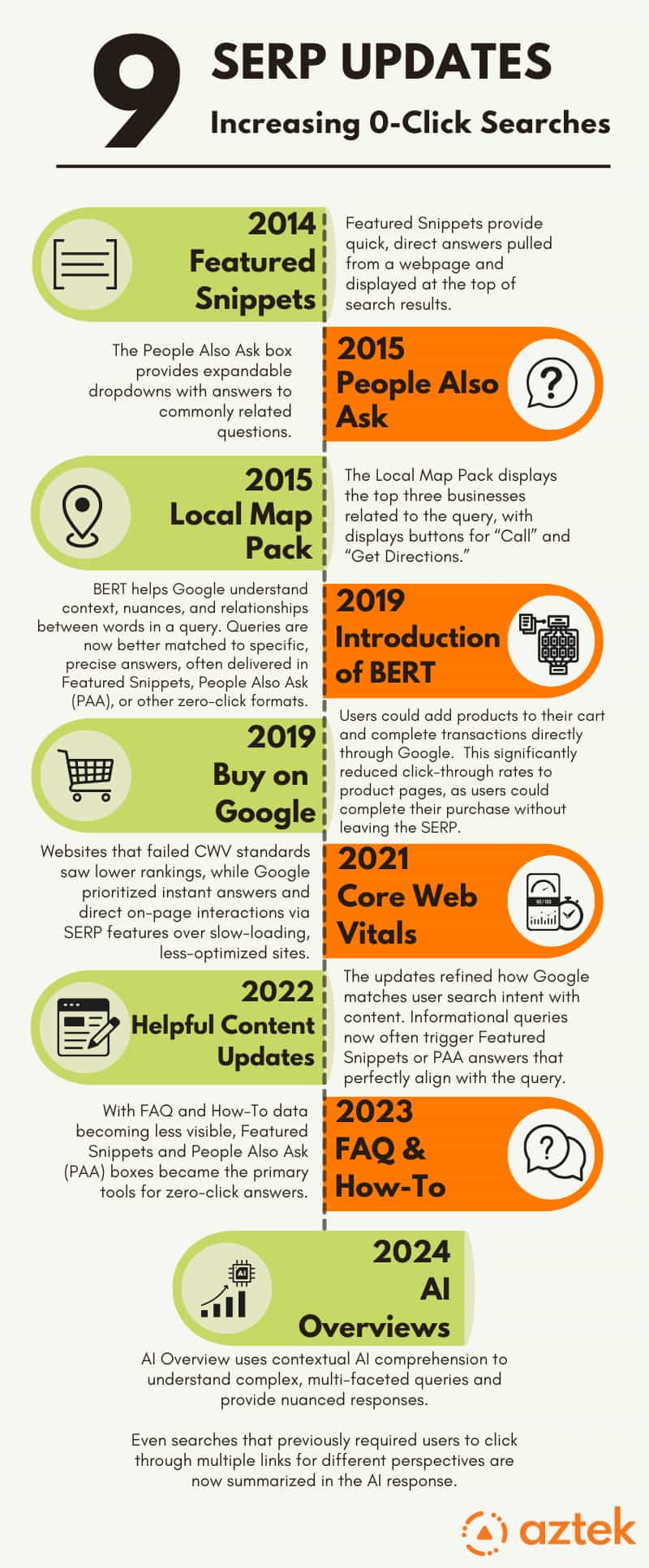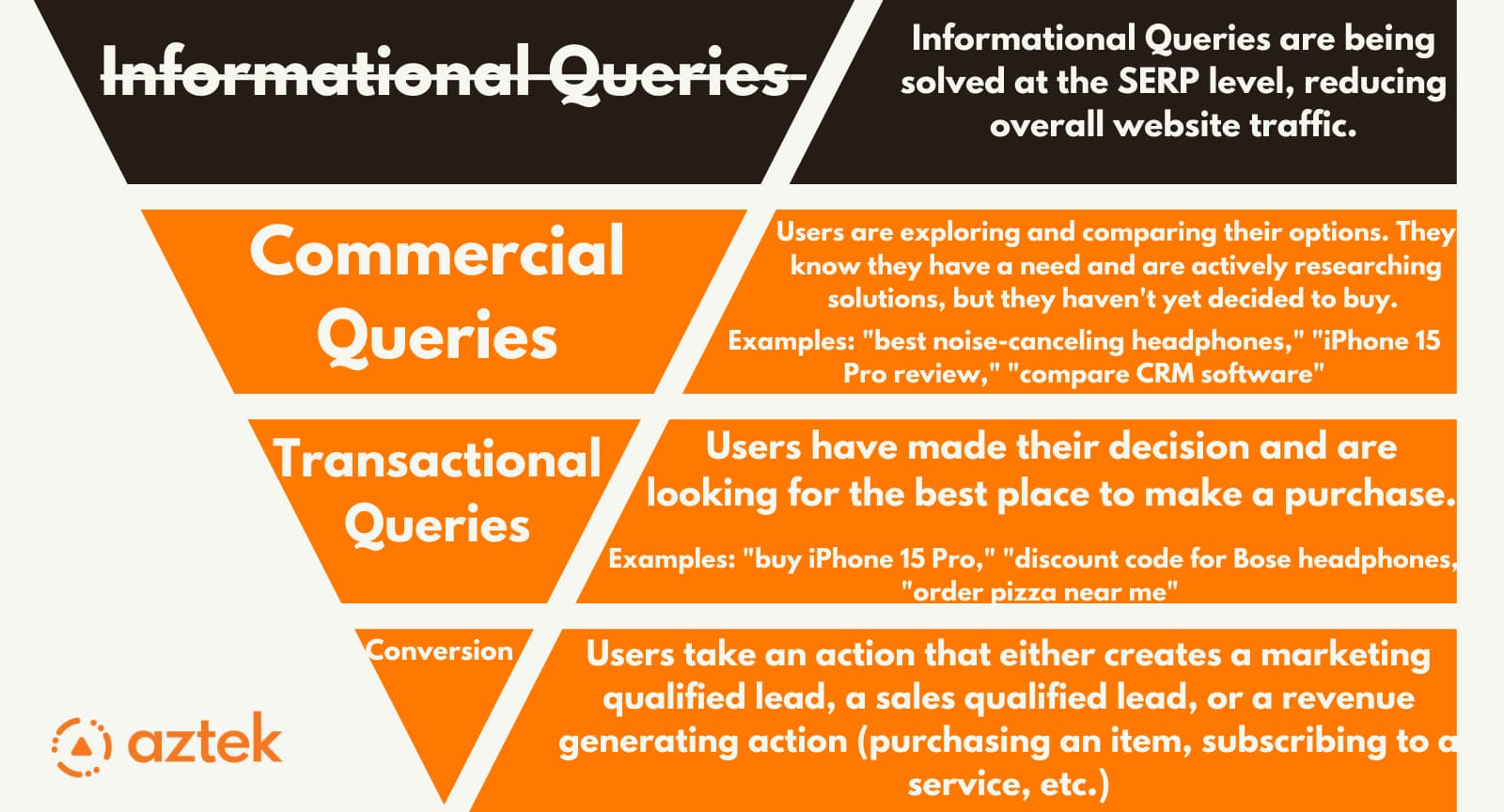For years, marketers relied on a tried-and-true model: full-funnel marketing. The funnel guided users seamlessly from awareness to purchase, with top-of-funnel (ToFu) content acting as a magnet for leads, emails, and remarketing opportunities. This model thrived when informational searches brought traffic to your website, allowing businesses to nurture visitors through the mid-funnel (MoFu) and into the bottom (BoFu), where conversions happened.
But here’s the reality in 2025 – full-funnel marketing, as we know it, is dying.
The Rise of Zero-Click Searches
Informational searches have quietly eroded in value over time. Recent data from Search Engine Journal shows that click-through rates for informational searches have plummeted as Google increasingly delivers answers directly on the Search Engine Results Page (SERP), minimizing the need for users to click through to a website.
This trend, known as "zero-click searches," now accounts for nearly 65% of all Google searches according to SparkToro, though this number has been debated by later research performed by SEMRush.
But how did we get here? The evolution of the SERP has been a gradual process, marked by key milestones:
- 2014 - Featured Snippets: By displaying concise answers directly on the SERP, Featured Snippets reduced the need for users to click through to websites for basic information. This addition marked the beginning of Google's shift towards providing instant answers.
- 2015 - People Also Ask: This feature further expanded on the concept of zero-click searches by providing answers to related questions, keeping users on the SERP and reducing the need to conduct multiple searches or visit external websites.
- 2015 - Local Map Pack: By prominently displaying local businesses, the Local Map Pack provided users with immediate access to contact information and directions, often eliminating the need to visit a business' website.
- 2019 - Introduction of BERT: BERT is a language model that enabled Google to better understand the intent behind search queries, leading to more accurate and relevant zero-click results. The introduction of BERT meant users were more likely to find the information they needed directly on the SERP.
- 2019 - Buy on Google: This feature allowed users to complete transactions without leaving Google, further reducing the need to visit external websites and contributing to the rise of zero-click searches for product-related queries.
- 2021 - Core Web Vitals: By prioritizing websites that offered a good user experience, Google incentivized website owners to optimize for speed and mobile-friendliness. In turn. Core Web Vitals indirectly contributed to the rise of zero-click searches as quicker loading times made it easier for Google to extract information for Featured Snippets and other SERP features
- 2022 - Helpful Content Updates: This update aimed to prioritize content that was genuinely helpful to users, leading to even more informational queries being answered directly on the SERP through Featured Snippets and People Also Ask boxes.
- 2023 - FAQ & How-To: The reduced visibility of FAQ and How-To data on the SERP pushed website owners to focus on creating content that could be easily featured in zero-click formats like Featured Snippets and People Also Ask boxes.
- 2024 - AI Overviews: AI Overviews took zero-click searches to the next level by summarizing information from multiple sources, providing users with comprehensive answers without requiring them to click through multiple links. This shift significantly reduced the need to visit external websites for complex or multi-faceted queries.

These developments have significantly reduced the visibility of traditional ToFu content. Where websites once thrived as the starting point of the buyer journey, the SERP itself has become the top of the funnel.
Why the Traditional Funnel is Shrinking
In the past, ToFu content delivered significant value:
- Users clicked through to blogs, guides, and resources, with data showing that click-through rates for informational searches were historically as high as 40%, particularly for first-position organic results (First Page Sage).
- Businesses captured emails, tracked visits, and remarketed to visitors. A 2022 study by HubSpot showed that remarketing campaigns could increase conversion rates by up to 161%, particularly for leads captured through top-of-funnel content (HubSpot).
- By nurturing users at this early stage, businesses built momentum through the funnel.
As Google and other Search Engines are transforming and answering queries directly in their results pages, fewer users visit websites and our traditional ToFu traffic declines. This erosion of ToFu traffic has cascading effects:
- Fewer leads are captured for remarketing campaigns. A recent report from SparkToro found that zero-click searches have grown by over 20% in the past three years, dramatically reducing opportunities for lead capture (SparkToro).
- The mid-funnel audience becomes smaller, with businesses reporting up to a 30% drop in traffic for informational queries that traditionally fed the funnel.
- Overall revenue potential diminishes because fewer prospects make it to the consideration and purchase stages, particularly as top-of-funnel content underperforms in a zero-click environment.
This decline isn’t a momentary hiccup – it’s a fundamental shift in how users engage with search. The era of relying on top-of-funnel content for growth is over.
Don’t Spend More. Think Differently.
The knee-jerk reaction to losing ToFu traffic might be to spend more on advertising and content. the problem is that this approach is unsustainable. Instead, the solution lies in reframing how we think about content strategy.

The top of the marketing funnel is no longer your website – it’s now the Search Engine Results Page (SERP). Even without clicks, AI Overviews and zero-click results can create brand awareness by referencing your brand. The challenge is to make sure that your brand can capture intent-driven traffic when users enter the consideration stage (mid-funnel). This requires focusing on mid-funnel content that matches the user’s journey.
Shifting Focus to the Mid-Funnel
The mid-funnel is where your brand must now shine. Users who become aware of your brand through AI Overviews or zero-click searches will re-engage with the search engine when they’re ready to consider solutions – and this is where your opportunity lies.
Here’s how to adapt:
- Strengthen E-E-A-T (Experience, Expertise, Authoritativeness, Trustworthiness): (Backlinko.com)
- Create content clusters that address user intent from awareness to purchase.
- Showcase expertise through long-form guides, case studies, and actionable insights.
- Include author bios, credible sources, and reviews to build authority and trust.
- Optimize for Mid-Funnel Content:
- Prioritize content targeting commercial and transactional intent keywords.
- Examples include product comparisons, reviews, buying guides, and FAQs that satisfy user needs deeper in the funnel.
- Technical SEO Excellence:
- Ensure your content is optimized for AI Overview inclusion with structured formatting, schema markup, and clear headings.
- Optimize page load speed, mobile experience, and Core Web Vitals to capture mid-funnel intent.
- Build Content Clusters:
- Connect awareness, consideration, purchase, and brand loyalty content in a single ecosystem.
- For example, a blog about "best home security systems" (awareness) links to a detailed comparison guide (consideration), then to a product page (purchase).
Winning in the AI-Driven Funnel
AI has fundamentally changed the rules of SEO. Where ToFu once dominated, we must now build strategies that account for AI search behaviors and user journeys. The answer lies in:
- Creating content ecosystems that satisfy every stage of the funnel.
- Optimizing technical SEO to land in AI Overviews and zero-click results.
- Recognizing that brand awareness happens on the SERP, but conversions happen deeper in the funnel.
By focusing on mid-funnel opportunities, strengthening E-E-A-T, and adapting to AI-driven search, businesses can thrive in this new landscape.
The funnel isn’t dead – but it has evolved. To stay ahead, we must evolve with it.
Contact us today to schedule a consultation and see how we can help your business adapt to the rise of AI in search. Let us help you build a strategy that drives results in this evolving digital landscape.
Download: How to Choose the Right Digital Marketing Agency
Trying to find a partner who can drive results through practical strategies? Download our guide to learn what you should consider when looking for an agency that's right for your organization.





